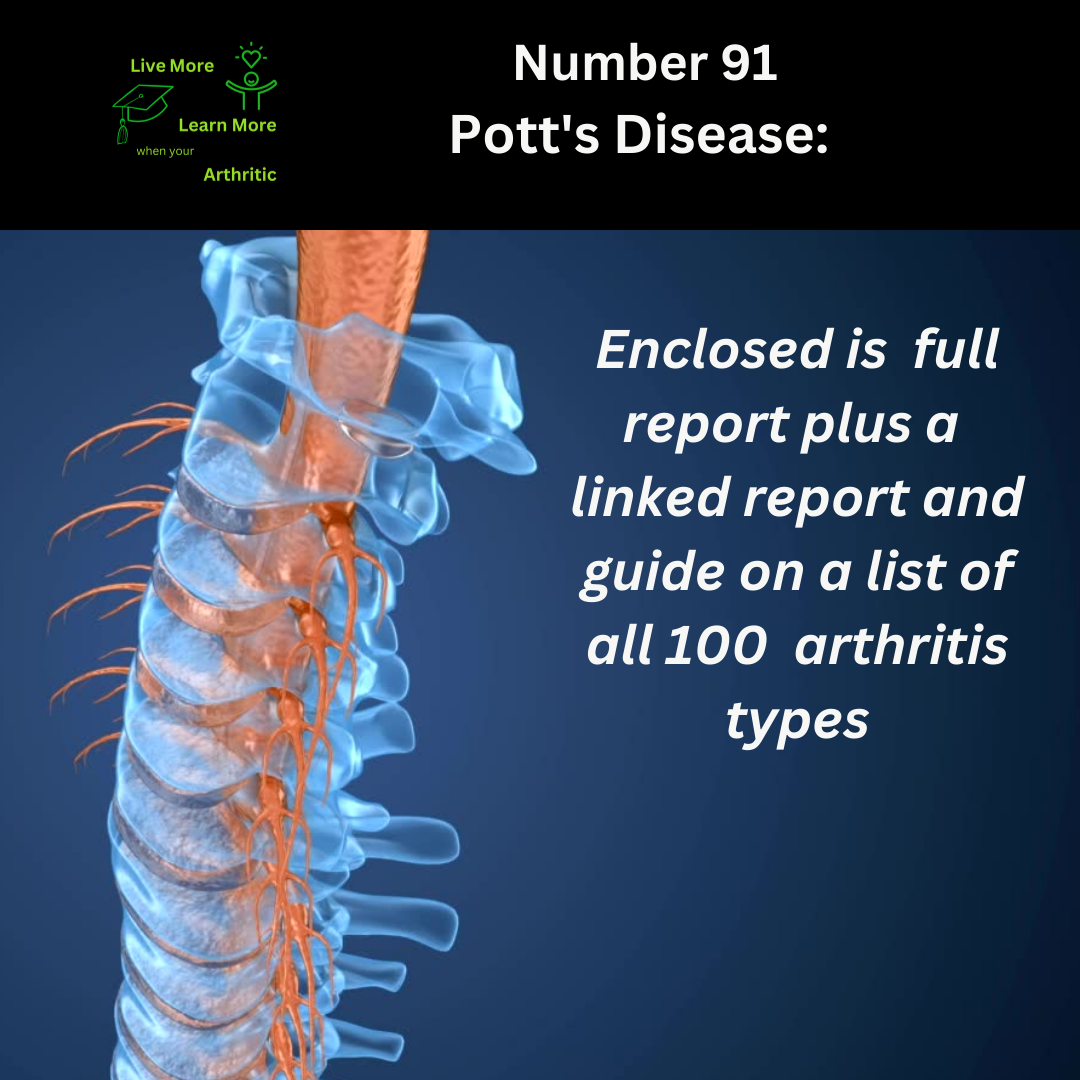
Pott’s Disease: Number 91 on the list of 100 types of Arthritis
Understanding Pott’s Disease: An Insight into Spinal Tuberculosis
Most Affected Body Parts and Joints
Pott’s disease, a form of extrapulmonary tuberculosis, primarily affects the spine (vertebrae), particularly the lower thoracic and lumbar regions. However, it can also involve other joints and tissues, such as the hips and knees, due to systemic spread of the tuberculosis bacteria.
Pott’s disease, named after British surgeon Sir Percivall Pott, is a type of tuberculosis that specifically targets the spine. It occurs when Mycobacterium tuberculosis, the bacteria responsible for tuberculosis, infects the vertebrae, leading to vertebral destruction, collapse, and spinal deformity. This can result in chronic back pain, neurological deficits, and disability if not treated promptly.
Causes and Triggers
The primary cause of Pott’s disease is infection with Mycobacterium tuberculosis. The bacteria typically spread to the spine from an initial pulmonary (lung) infection via the bloodstream or lymphatic system. Risk factors include close contact with individuals infected with tuberculosis, immunocompromised status (e.g., HIV/AIDS), and poor living conditions.
Symptoms and Limited Range of Motion
Symptoms of Pott’s disease include persistent back pain, especially at night or with movement, along with stiffness and reduced range of motion in the affected spinal segments. As the disease progresses, patients may develop neurological symptoms such as weakness, numbness, or difficulty walking due to spinal cord compression or nerve root involvement.
Age of Onset and Demographics
Pott’s disease can affect individuals of all ages but is more commonly seen in adults aged 30 to 50 years. Men are slightly more affected than women, possibly due to occupational or lifestyle factors. Children may also develop Pott’s disease, particularly in regions with a high prevalence of tuberculosis.
Complications and Impact on Quality of Life
Untreated Pott’s disease can lead to severe complications, including spinal deformity (kyphosis or gibbus deformity), paralysis, and permanent neurological deficits. Chronic pain, disability, and decreased quality of life are significant impacts of advanced Pott’s disease.
Is it Autoimmune?
Pott’s disease is not an autoimmune disorder but rather an infectious disease caused by Mycobacterium tuberculosis.
Risk Factors
Key risk factors for developing Pott’s disease include:
- Close contact with individuals with active tuberculosis
- Immunocompromised conditions (e.g., HIV/AIDS, diabetes)
- Malnutrition and poor living conditions
- Travel or residence in regions with a high prevalence of tuberculosis
Achieving a Higher Quality of Life
A proactive approach to managing Pott’s disease is essential for improving outcomes and quality of life. This includes:
- Early diagnosis and prompt initiation of antituberculosis therapy (e.g., antibiotics)
- Spinal bracing or orthotic support to prevent deformity and support spinal alignment
- Physical therapy to maintain mobility, strength, and flexibility of the spine
- Surgical intervention in advanced cases to stabilize the spine and decompress neural structures
Possible Complications
Complications of Pott’s disease include chronic pain, spinal deformity, neurological deficits (e.g., paralysis), and impaired respiratory function in severe cases. Joint tuberculosis (e.g., hip or knee) and disseminated tuberculosis affecting other organs can also occur.
 Interconnected Diseases or Conditions
Interconnected Diseases or Conditions
Individuals with Pott’s disease may be at increased risk of developing other forms of extrapulmonary tuberculosis, such as renal tuberculosis or tuberculous meningitis. Close monitoring and comprehensive care by infectious disease specialists and orthopedic surgeons are essential for managing these interconnected conditions effectively.
In summary, Pott’s disease is a serious manifestation of tuberculosis that primarily affects the spine, leading to vertebral destruction, spinal deformity, and neurological complications if left untreated. Understanding the disease process, risk factors, and management strategies is crucial for optimizing outcomes and achieving a higher quality of life for individuals affected by Pott’s disease.


